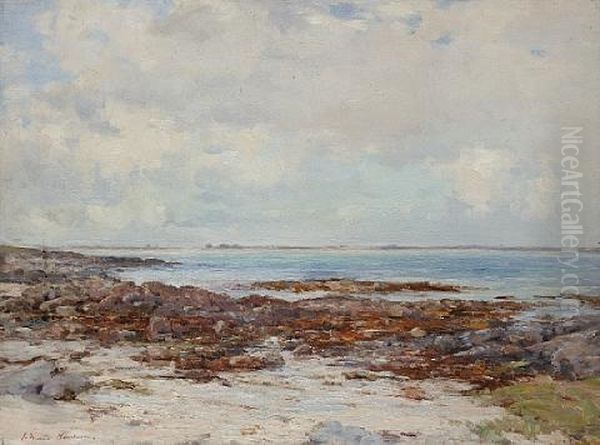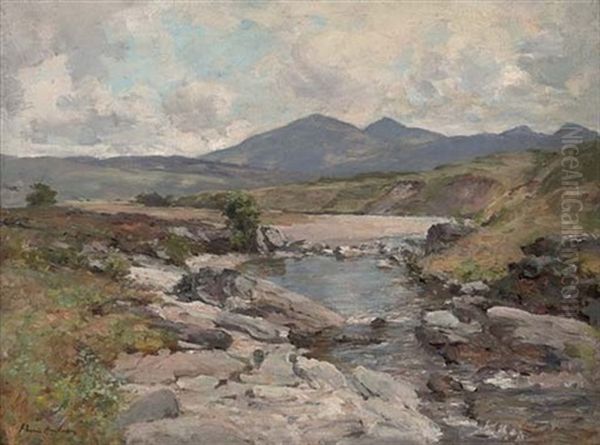Joseph Morris Henderson stands as a significant figure in Scottish art during the late nineteenth and early twentieth centuries. Born in Glasgow in 1863 and passing away in 1936, his artistic career traced a fascinating path from the disciplined world of portraiture to the evocative, light-filled realms of landscape and seascape painting. Henderson navigated the evolving artistic currents of his time, absorbing influences while developing a distinct voice, particularly noted for his later, more colourful and atmospheric works that captured the essence of the Scottish coasts and countryside. His journey reflects not only personal artistic development but also broader shifts within the Scottish art scene, moving towards greater freedom in expression and a heightened sensitivity to the effects of light and colour.
Early Life and Artistic Beginnings
Henderson's initial foray into the art world was firmly rooted in the tradition of portrait painting. In the late Victorian era, portraiture was a vital genre, providing steady commissions and a clear measure of an artist's technical skill. Glasgow, a burgeoning industrial and cultural centre, offered ample opportunities. Henderson established a reputation by capturing the likenesses of local dignitaries, businessmen, and prominent figures within the community. These early works likely adhered to the prevailing academic standards, emphasizing accurate representation, careful draughtsmanship, and a relatively sober palette, designed to convey the status and character of the sitter.
His training, likely undertaken at the Glasgow School of Art or through private tutelage, would have equipped him with the foundational skills necessary for this demanding genre. The influence of earlier Scottish masters of portraiture and narrative painting, such as Sir Henry Raeburn, Thomas Duncan, or the Faed brothers, John Faed and Thomas Faed, might be discerned in his early approach. These artists represented a strong national tradition that balanced technical proficiency with insightful characterization. Henderson's early career, therefore, was built on mastering these conventions and serving the patronage network of his native city.
The Glasgow Context and Shifting Tides

Henderson's formative and early professional years coincided with a period of dynamic change in Scottish art, particularly centred around Glasgow. The group known as the "Glasgow Boys," including figures like James Guthrie, John Lavery, George Henry, E. A. Hornel, and E. A. Walton, were challenging the established norms of the Royal Scottish Academy. They championed realism, plein air (outdoor) painting, and were influenced by French Naturalism, particularly the work of Jules Bastien-Lepage. Their focus on rural life, contemporary scenes, and bolder techniques marked a significant departure from traditional historical or sentimental subjects.
While Henderson may not have been a core member of the Glasgow Boys movement, he undoubtedly operated within this stimulating environment. The emphasis on direct observation, the exploration of light effects, and the move towards looser brushwork that characterized the movement likely resonated with him, even as he continued his portrait practice. This artistic ferment provided a backdrop against which his own later stylistic evolution can be understood. The questioning of academic constraints and the embrace of modern European influences were in the air, paving the way for artists like Henderson to explore new directions later in their careers. Arthur Melville, another contemporary associated with the Glasgow Boys, was particularly noted for his innovative watercolour techniques and bold use of colour, further enriching the artistic landscape.
A Defining Shift: Embracing Landscape
Around the turn of the century, when Henderson was in his early forties, a significant transformation occurred in his artistic output. He began to move away from the primary focus on portraiture that had defined his early career, turning instead towards landscape, seascape, and coastal scenes. This was a deliberate and profound shift, redirecting his artistic energies towards capturing the natural world, particularly the distinctive light and atmosphere of Scotland. The reasons for this change could be multifaceted: a personal desire for greater expressive freedom, the influence of contemporaries who had already embraced landscape, or perhaps a response to the changing tastes of patrons and the public.
His chosen subjects often included the varied coastlines of Scotland, possibly the Ayrshire coast or other areas known for their picturesque beauty and dramatic interplay of sea, sky, and land. This move placed him in dialogue with a strong Scottish tradition of landscape and marine painting. The towering figure in this field was William McTaggart, whose expressive, near-abstract depictions of the sea and coast, heavily influenced by Impressionism yet distinctly Scottish, set a high benchmark. Henderson's engagement with similar themes suggests an awareness of McTaggart's legacy and a desire to contribute his own vision to this genre. His landscapes became the primary focus of his mature work.
Style and Technique: Capturing Light and Atmosphere

Henderson's later works are characterized by a marked increase in vibrancy and a more impressionistic handling of paint. His palette brightened considerably compared to his earlier portraits, reflecting a keen observation of natural light and its effects on colour. Brushwork became looser and more visible, suggesting form and texture rather than delineating every detail with meticulous precision. This approach allowed him to capture the fleeting qualities of weather, the shimmer of light on water, or the atmospheric haze of a Scottish morning. His focus shifted from purely representational accuracy towards conveying mood and sensory experience.
While often described as "Impressionistic," Henderson's style retained a sense of structure and solidity that distinguished it from some French Impressionists like Claude Monet or Alfred Sisley. His work might be seen as absorbing Impressionist principles – particularly the emphasis on light, colour, and contemporary scenes painted outdoors – but filtering them through a Scottish sensibility. Some contemporary or later observations noted a connection to "colour separationism," which might suggest an awareness of Divisionist or Pointillist ideas, perhaps employing broken colour techniques to enhance luminosity, though likely not adhering strictly to the scientific theories of artists like Georges Seurat. This evolving technique aimed at achieving a greater sense of immediacy and visual truth.
Subject Matter: Portraits, Coasts, and Seas
Throughout his career, Henderson's subject matter encompassed both the human figure and the natural world, though the emphasis shifted over time. His early portraits, as discussed, focused on capturing the likenesses and status of individuals within Scottish society. Even after his turn towards landscape, he likely continued to accept portrait commissions periodically. A known example, such as the "Portrait of Provost Muir," exemplifies this aspect of his oeuvre, showcasing his skills in rendering character and formal attire, likely dating from his earlier period or representing a continued engagement with the genre.
However, his reputation increasingly rested on his landscapes and seascapes. Works like "A Summer Day, Ayrshire Coast" or "Low Tide" (representative titles capturing the essence of his typical subjects) evoke the specific character of the Scottish coastline. He painted harbours, beaches, estuaries, and the open sea, often under varying conditions of light and weather. His landscapes were not typically dramatic or sublime in the Romantic sense, but rather focused on the quieter beauty and atmospheric nuances of the Scottish environment. They aimed to capture the everyday reality and charm of coastal life and the subtle interplay of natural elements, reflecting a deep connection to his native land.
Exhibitions and Recognition
Joseph Morris Henderson achieved considerable recognition during his lifetime, exhibiting regularly at major institutions in Scotland and England. His presence at the annual exhibitions of the Royal Scottish Academy (RSA) in Edinburgh was crucial for establishing his reputation within the national art scene. Acceptance and display at the RSA signified peer recognition and brought his work to the attention of critics, collectors, and the wider public. Similarly, exhibiting at the Royal Academy (RA) in London provided exposure on a larger British stage, allowing his work to be seen alongside that of leading artists from across the UK.
He also frequently exhibited at the Royal Glasgow Institute of the Fine Arts, a key venue in his home city that played a vital role in promoting the work of West of Scotland artists. Consistent participation in these prestigious exhibitions helped solidify his standing as a professional artist. Furthermore, the acquisition of his works by public collections, such as the Lancaster City Museum & Art Gallery and the Smith Art Gallery and Museum in Stirling, provided lasting validation. These acquisitions ensured that his paintings would be preserved and accessible to future generations, cementing his place within the narrative of Scottish art history. Other institutions, like Glasgow Museums, also likely hold examples of his work.
Henderson and His Contemporaries
Henderson operated within a rich and diverse Scottish art scene. While his later work shows an affinity with the Impressionist-influenced landscapes of William McTaggart, he carved out his own niche. His coastal scenes can be compared with those of other contemporaries like Robert Gemmell Hutchison, who also specialized in depicting coastal life and childhood subjects with sensitivity to light, though often with a more sentimental touch. Henderson's work generally maintained a balance between observed reality and atmospheric effect, perhaps less radically experimental than McTaggart but more modern in feel than many traditional landscape painters.
Although the provided information suggests no specific records of direct collaboration with other well-known painters, Henderson was undoubtedly aware of and likely interacted with many leading figures within the close-knit Scottish art community. His stylistic development occurred alongside the flourishing careers of the younger Scottish Colourists – S. J. Peploe, F. C. B. Cadell, Leslie Hunter, and J. D. Fergusson. While the Colourists pushed further towards Post-Impressionism and Fauvism with their exceptionally bold palettes and often more stylized forms, Henderson's work represents an earlier engagement with modern ideas of colour and light, remaining more closely tied to naturalistic observation. His contemporaries also included established figures from the Glasgow Boys generation like Sir John Lavery and James Guthrie, whose careers continued to evolve alongside his own.
Artistic Family and Legacy
A notable aspect of Joseph Morris Henderson's life is the continuation of artistic pursuits within his family. He had three sons who also became artists: John Henderson, Daniel Henderson, and potentially William Henderson (though less information might be available on the third). This suggests a household where art was valued and practiced, with the father's profession influencing the next generation. While details of his sons' specific careers and styles require further research, the existence of this artistic lineage underscores the depth of Henderson's commitment to his craft and its transmission within his family circle.
Joseph Morris Henderson's legacy lies in his contribution to Scottish painting during a period of transition. He successfully navigated the shift from traditional portraiture to a more modern, light-focused landscape style. His works are valued for their sensitive depiction of the Scottish coasts and countryside, capturing atmosphere and place with skill and sincerity. He is remembered as a respected member of the Scottish artistic establishment, whose paintings were appreciated during his lifetime and continue to be held in public collections. His journey reflects an artist adapting to new influences, particularly the pervasive impact of Impressionism, while retaining a distinctly Scottish character in his work. He stands as a documenter of his time and place, offering evocative glimpses into the landscapes and seascapes of early 20th-century Scotland.
Conclusion
Joseph Morris Henderson's career offers a compelling narrative of artistic evolution. Beginning as a proficient portrait painter in late Victorian Glasgow, he responded to the changing artistic climate and his own inclinations by embracing landscape and seascape painting. His later works, characterized by their brighter palette, looser brushwork, and sensitivity to light and atmosphere, demonstrate an engagement with Impressionist ideas adapted to a Scottish context. Exhibiting widely and gaining recognition through public collections, Henderson secured a respectable place in Scottish art history. Though perhaps not as revolutionary as some of his contemporaries like the Glasgow Boys or the later Colourists, his dedicated portrayal of Scotland's natural beauty, particularly its coasts, provides a valuable and enduring artistic legacy. His journey from the formal constraints of portraiture to the expressive freedom of landscape painting remains a testament to his adaptability and his lifelong dedication to capturing the world around him.